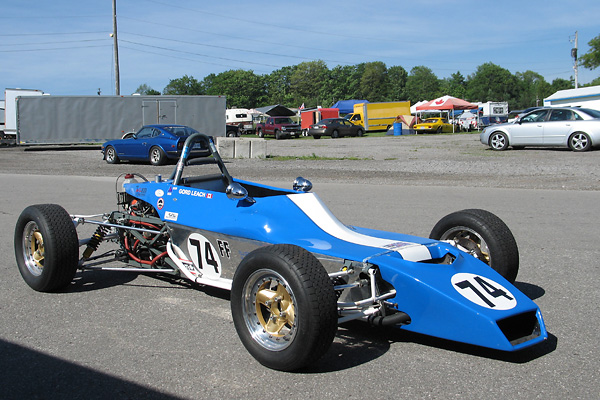
Gord Leach's 1974 Hawke DL11 Formula Ford Racecar
Owner: Gord LeachCity: Regina, Saskatchewan
Model: 1974 Hawke DL11
Engine: 1.6L Ford four-cylinder
Race prepared by: owner
David Lazenby and his Hawke Racing Cars
David Lazenby joined Lotus in 1961, and in 1963 he was assigned to be Jim Clark's race mechanic.
In this capacity he prepared and maintained Clark's Formula One and Indianapolis 500 cars.
Lazenby was a central figure in the small team that helped Clark win the 1965 Indy 500. His
career at Lotus looked bright. In 1968, Lazenby was named General Manager of Lotus Components Ltd.,
the division of Lotus which built racecars for outside customers. These were the early days of
the exciting new Formula Ford amateur racing class, and customer demand for Lotus 51 Formula Fords
was booming.
Apparently the promotion didn't suit Lazenby well enough, because at the end of the 1968
he resigned from Lotus and started his own racecar business. David Lazenby & Co. Ltd.
only sold a modest number of Formula Fords and never advanced into building cars for
professional racing classes, but ultimately Lazenby's company produced some very successful
Formula Ford racecars. David Lazenby was the principle designer of all their models.
From early 1969, Lazenby worked out of a small workshop in the cozy parish village of Nazeing
(near Waltham Abbey). Lazenby shared the shop with an old hawk, and soon appropriated and modified
the word "hawk" as a trade name for his products. The very first Hawke racecar was built to order
for the man who owned the workshop building. Retrospectively identified as a DL1, this car is
remembered as the prototype for the DL2, DL2A and DL2B models which followed.
The DL1 featured an unusually long nose cone which proved vulnerable in traffic, and also an
uncommonly well-braced frame because driver protection was a design priority from the company's
beginning. From the early days of his new enterprise, Lazenby kept bills paid by producing
close-ratio gears for the Renault gearboxes used in early Lotus Formula Fords. (Hewland gears
and steering racks became staple products later.) After a short while, Lazenby relocated to a
larger premises on the Waltham Cross high street.
Canada and the United States proved especially receptive markets for Hawke cars and sales grew.
According to a contemporary Motor Sport magazine article ("They Make Racing Cars", December 1971)
28 Hawke DL2 Formula Fords were built in 1969 followed by 54 Hawke DL2A cars in 1970. (The Hawke
Registry reports a much lower number.) A Hawke DL2A won the 1970 Canadian "Bulova Cup"
Formula Ford Championship. Aside from a handful of examples that prove the rule, DL2 and DL2A
frames were fabricated to order from Racing Frames and from Arch Motors respectively.
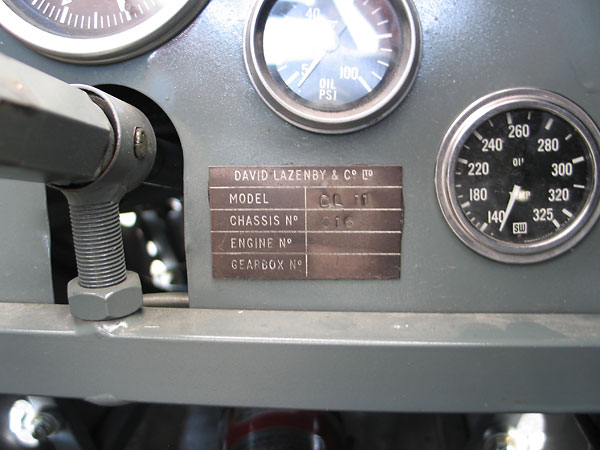
David Lazenby & Co. Ltd.
Model DL11, Chassis No. 016, Engine No. (blank), Gearbox No. (blank)
(Note also the custom fabricated adjustable steering column support.)
For 1971, production was split between the latest revision of the Formula Ford model (DL2B)
and a new Super Vee model (DL5). By late 1971, Hawke frame production moved in-house. Interestingly,
Hawkes always used fabricated steel uprights (a.k.a. hub carriers) rather than any sort of cast or
forged uprights. They reasoned and advertised that these were safer because they would likely
deform but not fracture in most severe accidents. Hawke kept most of their small fabricated parts
in-house. Several different suppliers were tried for fiberglass body panels. At least through the
early years, SAH Accessories in Leighton Buzzard was their preferred fiberglass supplier.
For 1972, production was split between two new models the Hawke DL8 for Super Vee and the Hawke DL9 for
Formula Ford. According to the company's sales literature, the two models had exactly the same
nominal wheelbase (88.5"), track (54.0" front and rear), and weight (882 pounds). What's really
interesting about these two models is the design of their space frames; instead of round tubes, these
new models and their successors were mainly constructed from box tubing and special "formed beams
in the cockpit to provide great strength and maximum driver protection." Whereas earlier Hawke
Formula Fords had nose pod mounted radiators, the DL9 had two side mounted Serck radiators supplemented
by a nose mounted oil cooler. About 30 Hawke DL9 race cars were produced.
For 1973, Super Vee had largely fizzled out and the company's production focused on a new
Formula Ford model, the Hawke DL10. Both the space frame and the body were substantially different
from the previous (DL9) model, but performance was disappointing. About 25 Hawke DL10 race cars were
produced, but many of them were upgraded to DL11 specifications. (Changes included updated rear
suspension pick-up points and geometry.)
Enjoying this article? www.BritishRaceCar.com is partially funded through generous support from readers like you!
To contribute to our operating budget, please click here and follow the instructions.
(Suggested contribution is twenty bucks per year. Feel free to give more!)
With the Hawke DL11 David Lazenby finally had a top performing Formula Ford design. The difference
came through extensive testing. An enthusiastic employee named John Bicht got on track and drove the
DL11 test mule at every reasonable opportunity over the course of its seven month development. Another
driver's name is also closely associated with the DL11: Syd Fox drove a DL11 to victory in the
1973 Sunbeam Electric Championship, and also to an impressive third place finish in the 1973 Formula
Ford Festival. (Formula Ford was a popular enough class in England through this era that three competing
championship series were held. The Formula Ford Festival ended up more prestigious than any of these
because it brought together top drivers from all over England and also from much of Europe.)
Although Formula Ford was still popular, sales were down for most race car constructors through
1973 and 1974. Following the Arab oil embargo, gasoline was a precious commodity and there were
persistent pernicious rumors that racing might be banned. Only about 30 Hawke DL11 race cars were
built, although production spanned from 1973 through 1974. Late in 1974, Lazenby produced a very
small number of specially streamlined "Super Slipstreamer" (a.k.a. DL12) Formula Fords. Roy Klomfass
drove a Super Slipstreamer to Sunbeam Electric Championship victory in 1974.
Even greater success awaited future Hawke models. Lazenby's cars dominated the 1976 Formula Ford
Festival with Derek Daly, Derek Warwick, and Rick Morris in a 1-2-3 finish (driving two DL17s and
one DL15, respectively.) A young driver named Nigel Mansell also drove a Hawke DL17 throughout his
1976 season.
Besides Gord Leach's car, the Hawke Registry lists ten remaining Hawke DL11 racecars (worldwide),
plus three DL12s. No Hawke DL10 racecars are known to have survived.
Discovered: Factory-Recommended Hawke DL11 Set-Up Measurements
| Front | Rear | ||
| Ride height | 2.75"-3" | 3.5"-3.75" | |
| Camber | 0.5 degree | 1 degree | |
| Castor | 0.75 degree | 0 degree | |
| Toe-in | 1/16" each wheel | 1/16" each wheel | |
| Dampers | 1 turn | 1.75 turn | |
| Tire pressure | 14-16 psi | 16-18 psi |
Features and Specifications
| Engine: | 1.6L Ford four-cylinder, built by Brian Stewart Racing Inc., Toronto Canada.
Weber 32/36 DGV carburetor.
Shankle tuned length velocity stacks (used without filters).
Motorcraft distributor.
Belden Premium 7mm spark plug wires.
Rowland Ford oil pump.
Mocal remote oil filter mount.
Fram PH2950 oil filter.
Mocal 10-row oil cooler. |
| Cooling: | original copper/brass crossflow radiator. |
| Exhaust: | four-into-one header. |
| Transmission: | Hewland Mark 8 4-speed. |
| Front Susp.: | unequal length wide-based wishbones.
Hawke proprietary fabricated steel uprights.
Spax steel bodied adjustable coilover shock absorbers.
Adjustable tubular 5/8" anti-sway bar. |
| Rear Susp.: | dual lower links, single top links, and twin adjustable trailing links.
Hawke proprietary fabricated steel uprights.
Spax steel bodied adjustable coilover shock absorbers.
Adjustable tubular 1/2" anti-sway bar. |
| Brakes: | (master) dual Girling master cylinders with integral reservoirs, and with bias bar. (front) Lockheed LD20 calipers. Cross-drilled rotors. (rear) Lockheed LD20 calipers. Cross-drilled rotors. |
| Wheels/Tires: | Revolution modular (3-piece) aluminum wheels.
Dunlop Racing "Formula Ford" tires (135/545-13 CR82 front, 165/580-13 CR82 rear). |
| Electrical: | Lucas master battery cutoff switch.
PowerSonic PS12180 sealed absorbent glass mat lead/acid battery. |
| Instruments: | (left to right) Stewart Warner water temperature gauge (100-230F),
Jones mechanical tachometer (0-10000rpm),
Stewart Warner oil pressure gauge (5-100psi).
Stewart Warner oil temperature gauge (140-325F).
|
| Fuel System: | ATL FC152 5-gallon fuel cell.
FF1600 mechanical fuel pump with push-on fittings. |
| Safety Eqmt: | Racers Choice six-point cam-lock safety harness.
Phoenix centralized fire suppression system.
Quick release steering wheel hub, on a Moto-Lita steering wheel. |
| Racing Class: | Formula Ford. |
Engine Installation
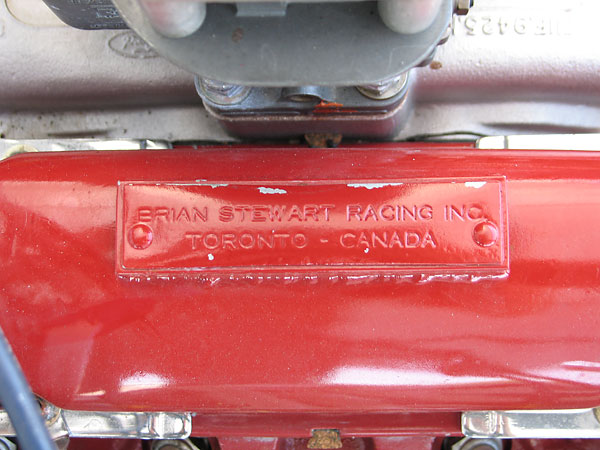
Brian Stewart Racing Inc. of Toronto once built this engine. Mechanic, turned Formula Ford championship winning
driver, turned professional racing team owner... Brian Stewart is among the best known and most respected figures
in Canadian racing. His team won the Indy Lights championship in 2005. BSR is also a full service race shop.
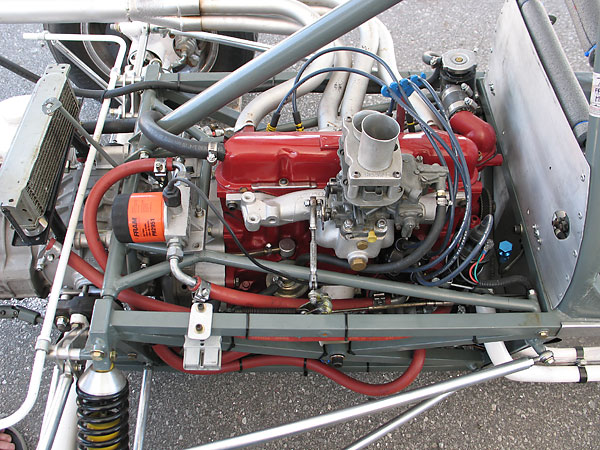
Weber 32/36 DGV carburetor on an original Ford intake manifold, as mandated by class rules.
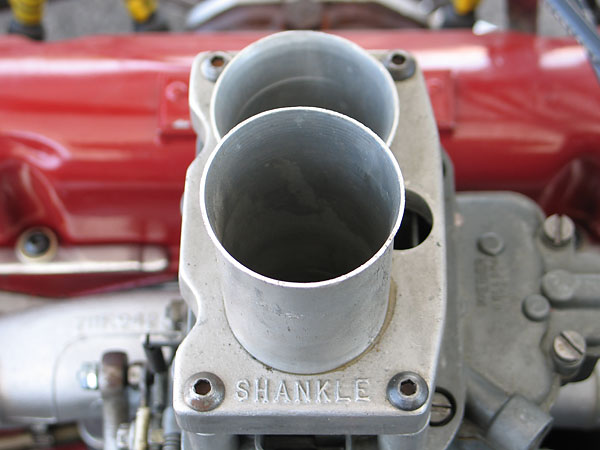
Shankle velocity stacks are designed to make altering induction tract length easy. The effect is somewhat like
optimizing exhaust lengths. Trimming the trumpets generally shifts peak torque to a higher engine speed.
Fitting longer trumpets has the opposite effect. In either case, the bell of the trumpet helps smooth airflow
into the induction tract. (The bigger the bell radius, the better.) Here, one stack is shorter than the other.
This may have been done to correct mismatched intake manifold runner lengths.
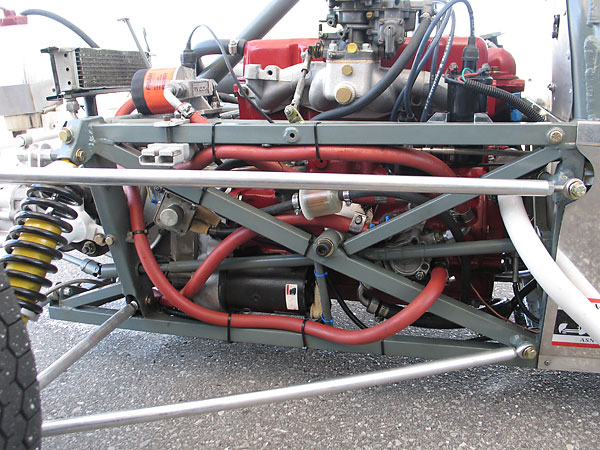
Full size starter motor.
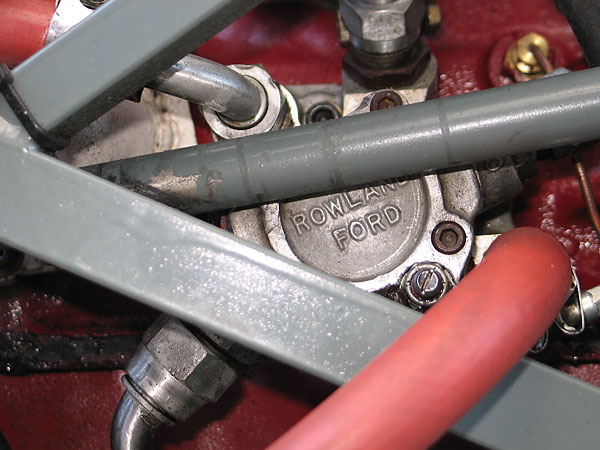
Rowland Ford oil pump.
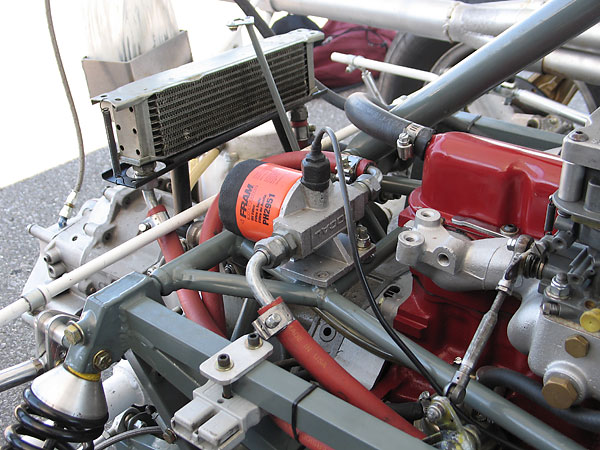
Mocal remote oil filter mount and Fram PH2950 oil filter. Mocal 10-row oil cooler.
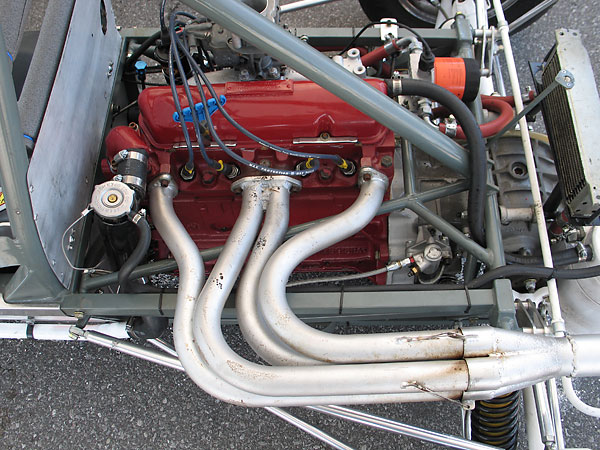
4-into-1 exhaust header. Girling clutch slave cylinder.
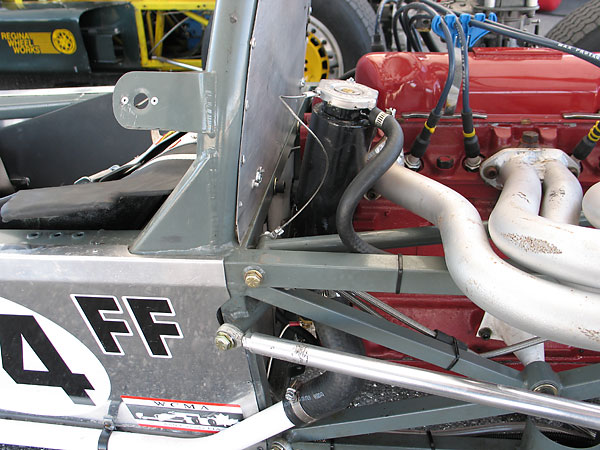
The filler cap is up high to ensure that coolant fills the cylinder head's water jacket.
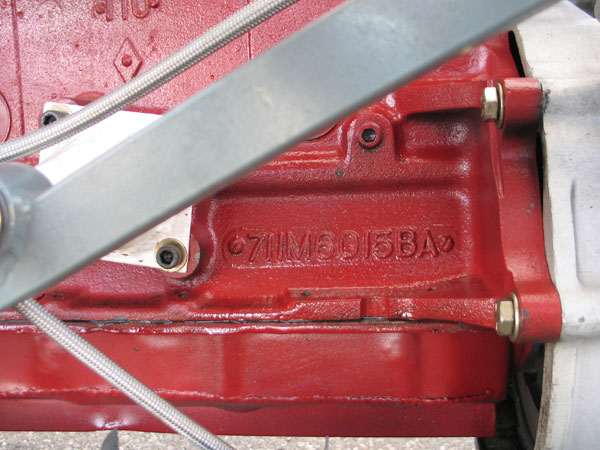
Casting number 711M6015BA indicates that this block is a 1600cc "tall" block with big bearing caps.
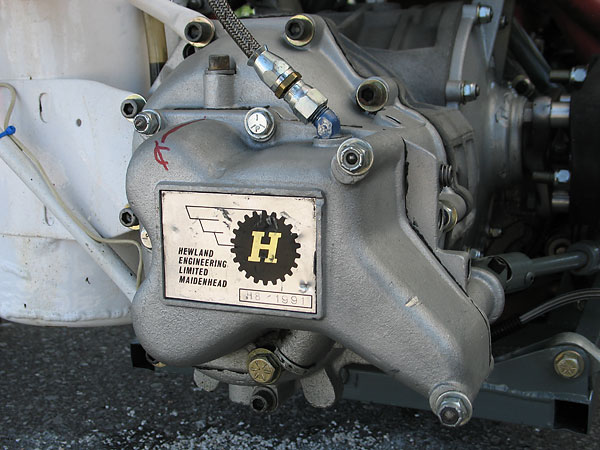
Hewland transaxle: H8-1991
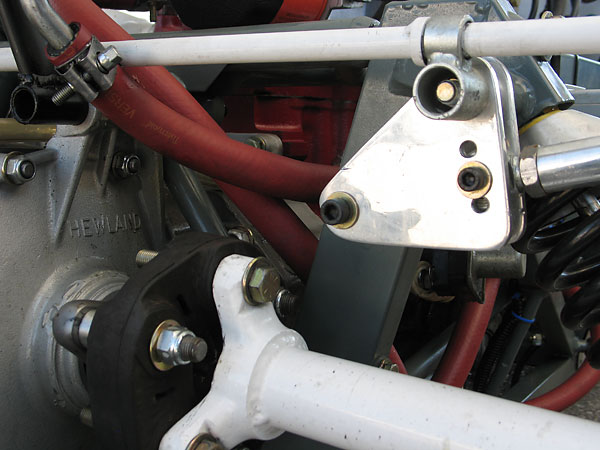
Metalastic drive donuts are a characteristic component of vintage Formula Fords.
Front Suspension, etc.
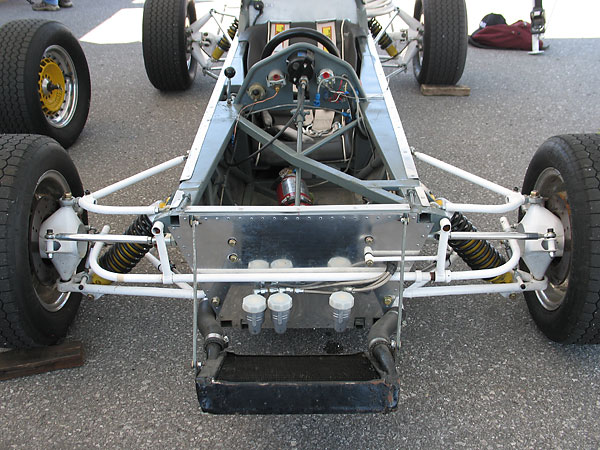
One unusual feature of all Hawke suspensions is their fabricated steel front and rear uprights (a.k.a. hub
carriers). Their competitors mainly used Alford and Alder forged front uprights (from Triumph street cars)
or custom magnesium castings. Hawke promoted their steel uprights as a safety over magnesium or
aluminum castings because they're more likely to bend rather than break in an accident.
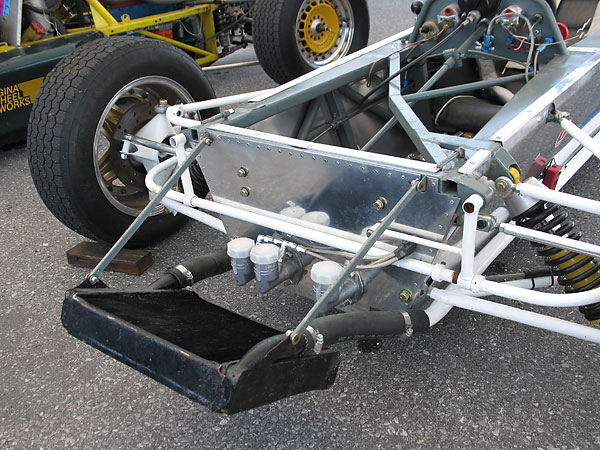
Whereas many early Formula Ford constructors routed coolant to front-mounted radiators through
frame tubes, Hawke preferred to mount coolant lines outboard of the frame. Note also that this
original copper-and-brass radiator is flexibly supported by just two stay rods and two hoses.
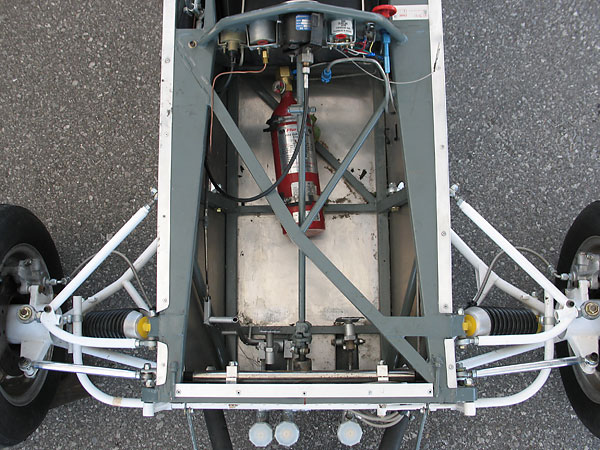
This frame is primarily composed of square "box" tubing, where other early Formula Ford designs
mainly used round tubing. Among the advantages of box tubing: frame joints are easier to fabricate
since no "fishmouth" cuts are required and the flat surfaces of the tubes make it easier to install
bulkheads or to mount accessories. Generally, round-tube frames can be made lighter weight.
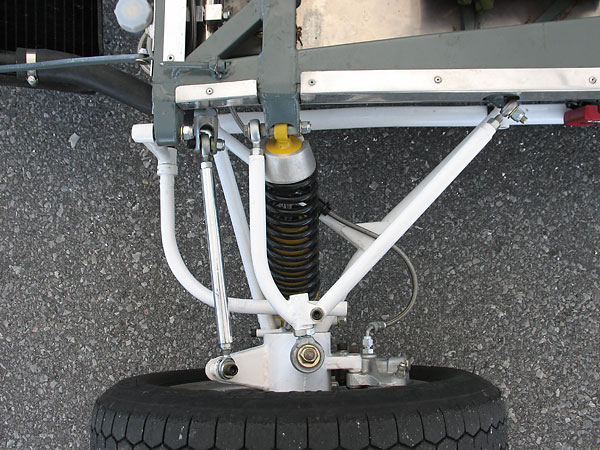
Mounted atop the corner of the frame, you can see one of the pins that locate the bodywork.
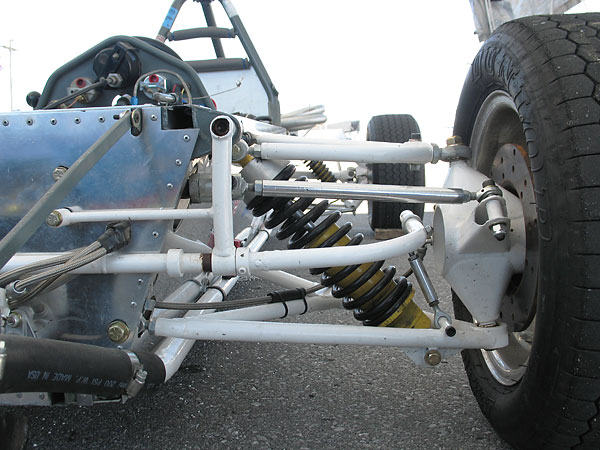
Old Hawke sales literature indicates that either Armstrong or Spax shock absorbers were provided.
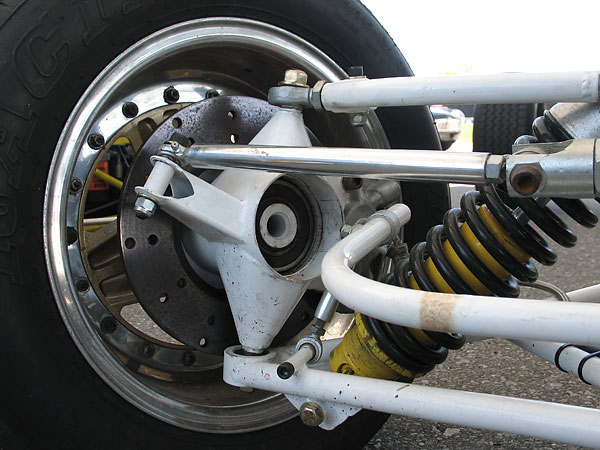
Evidentally to correct a bump steer issue, steering links have been reconnected to the uprights above
their normal connection point. (In the "before picture", steering links were connected this way too.)
In this view, you can also see the shock absorber adjustment valve.
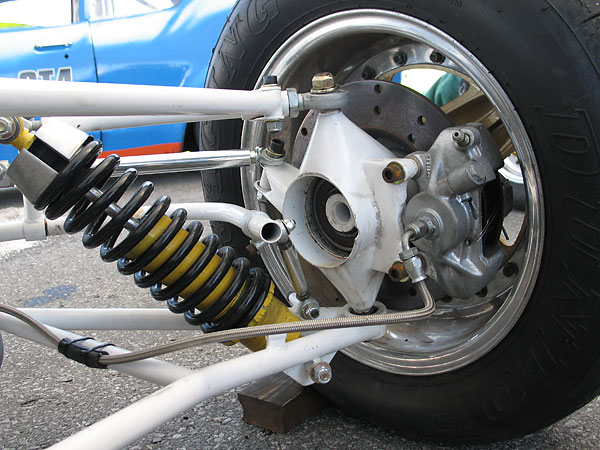
Vintage Formula Ford racecars use steel-bodied shock absorbers. (Club rules prohibit aluminum shocks.)
In this view you can also see that the car has Lockheed LD20 calipers, which would have been a very
modern spec for 1973. Up until that time, Girling calipers were ubiquitous in Formula Ford.
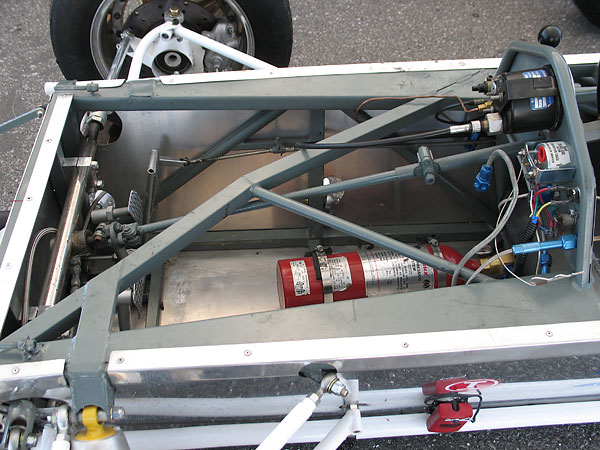
Note the clamp on the steering column which facilitates moving the steering wheel rearward.
This view also shows the wide spacing of rivets on the car's aluminum side panels. Class rules
explicitly prohibited closer rivet spacing to keep side panels from functioning as "stressed skins".
(It was a stupid rule for many reasons. For example, adhesives were already available which were
stronger than rivets and completely undetectable without dissassembly. Besides, why shouldn't a
race car chassis be as strong and as safe as possible, especially when the difference is so cheap?)
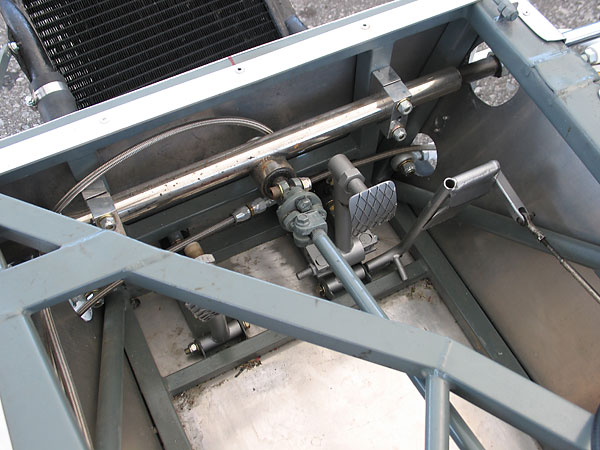
Unlike many other early Formula Fords, on the Hawke DL11 the steering rack is mounted rearward of the
frame's front bulkhead. Hawke constucted their own steering racks, and in fact offered custom made
steering racks for all sorts of applications. Note also the flexible steering shaft coupling (a.k.a. rag joint).
Rear Suspension
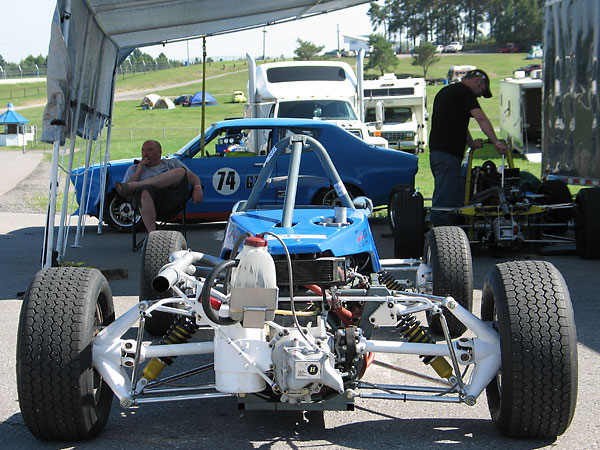
Dual lower links, single top links, and twin adjustable trailing links.
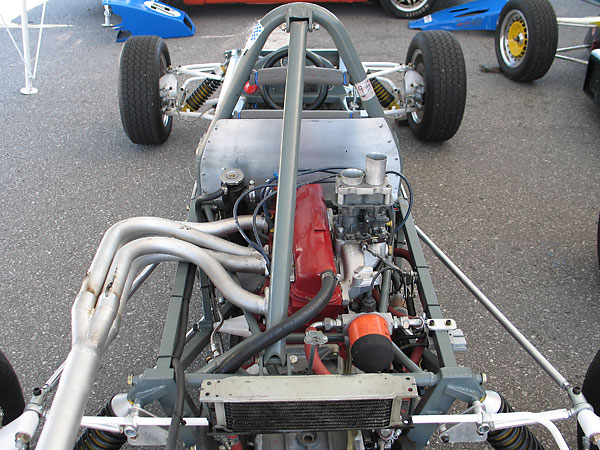
A robust roll hoop brace.
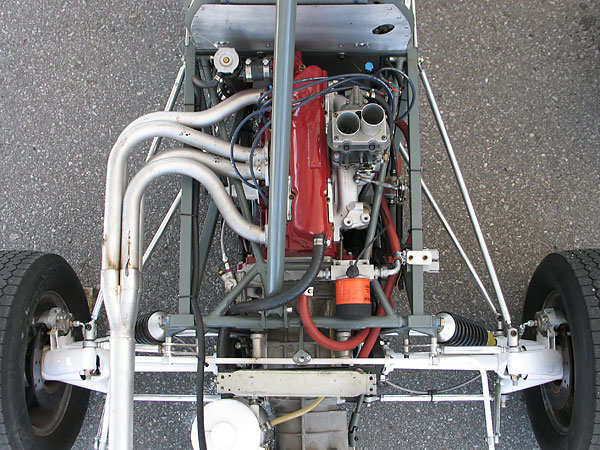
When Gord purchased his DL11, it had a canister muffler clamped just behind the exhaust collector.
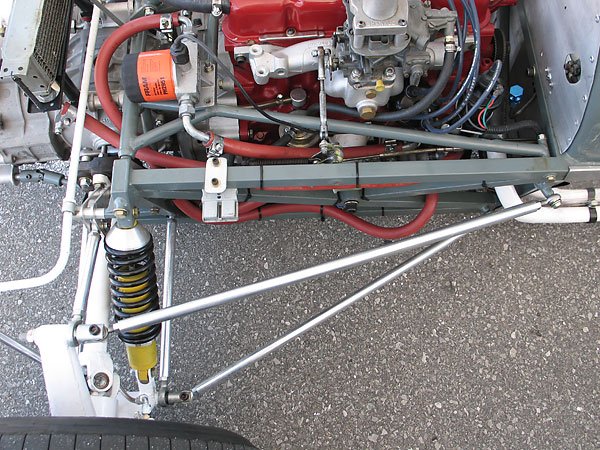
One way to make radius rods is to drill and tap holes into the ends of solid extruded aluminum bars.
The original radius rods were made from steel tube with welded-on threaded plugs at each end.
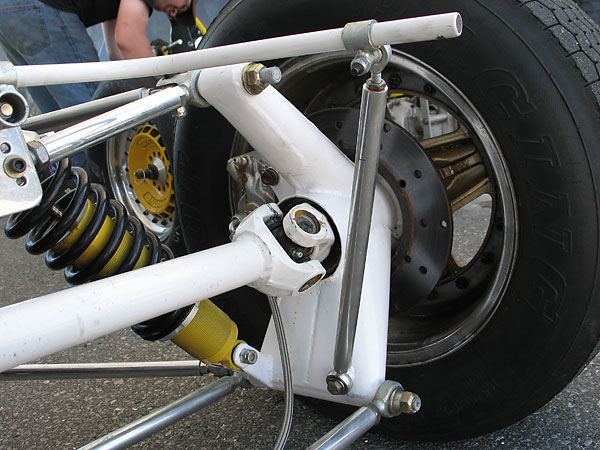
The core of a solid anti-sway bar adds very little to its torsional stiffness, so it makes
excellent sense to use tubing instead - as shown on both the front and rear of this racecar.
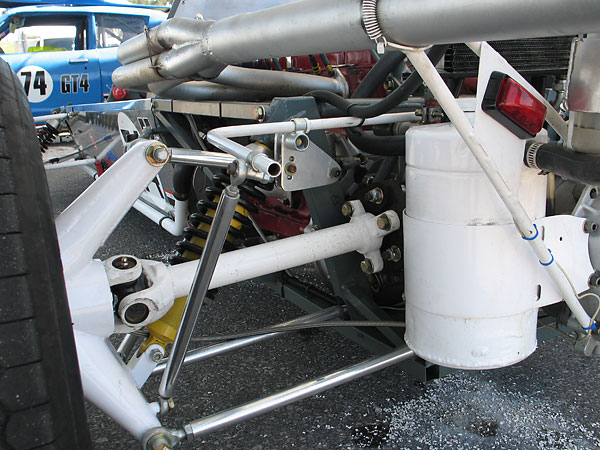
Although painted now, the engine oil reservoir is an aluminum fabrication.
Interior
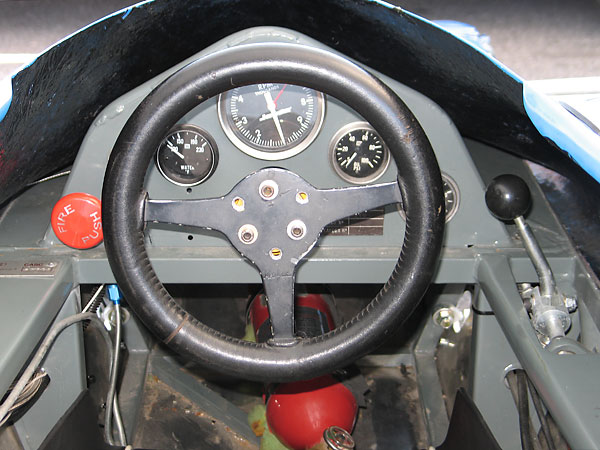
Moto-Lita steering wheel.
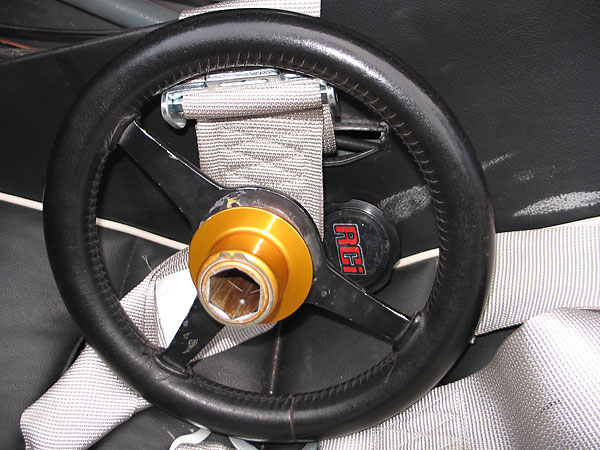
Quick release steering wheel hub.
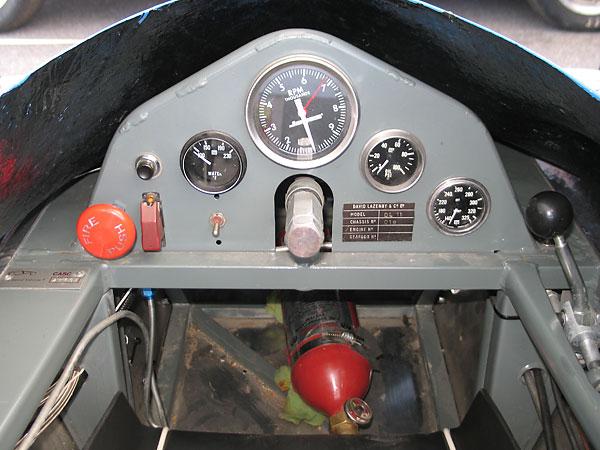
Stewart Warner water temperature gauge (100-230F), Jones mechanical tachometer (0-10000rpm),
Stewart Warner oil pressure gauge (5-100psi) and oil temperature gauge (140-325F).
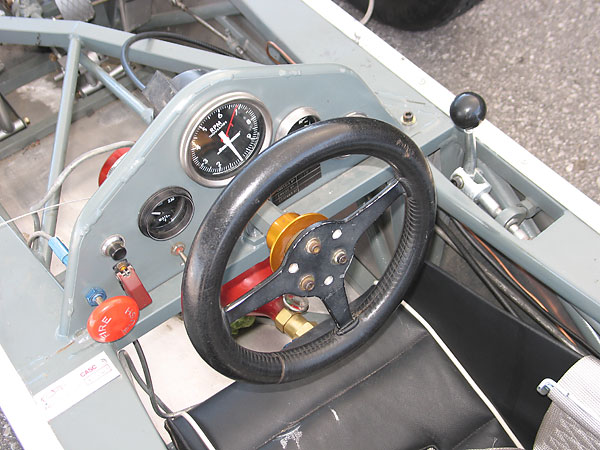
Fabricated steel instrument panel.
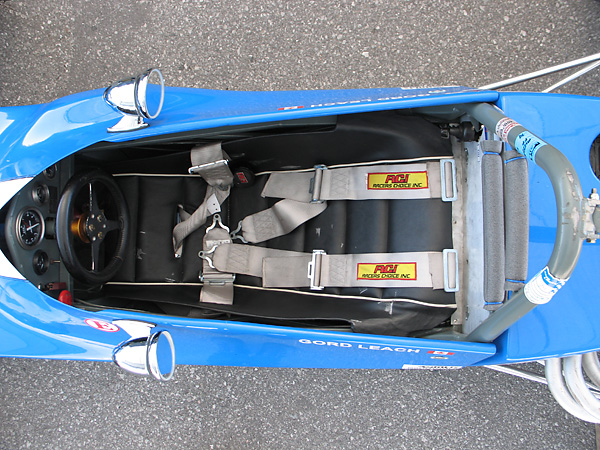
Racers Choice six-point cam-lock safety harness.
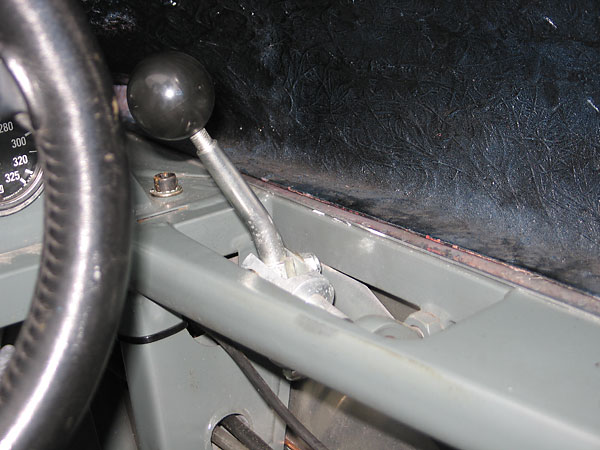
Gear selector.
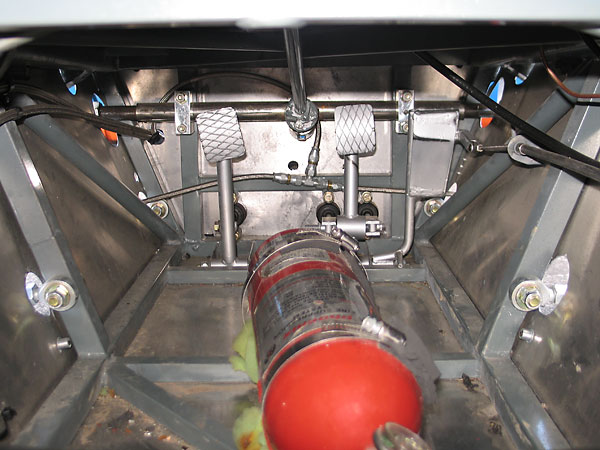
Phoenix centralized fire suppression system.
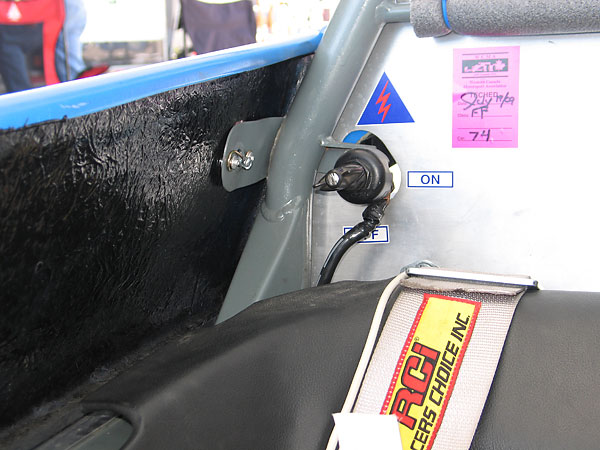
Lucas master battery cutoff switch.
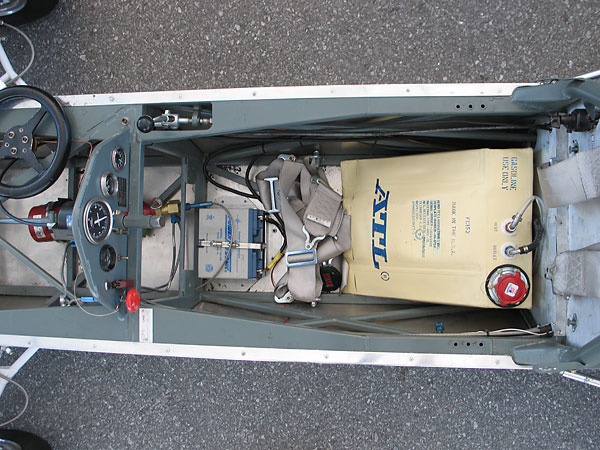
PowerSonic PS12180 sealed absorbent glass mat lead/acid battery.
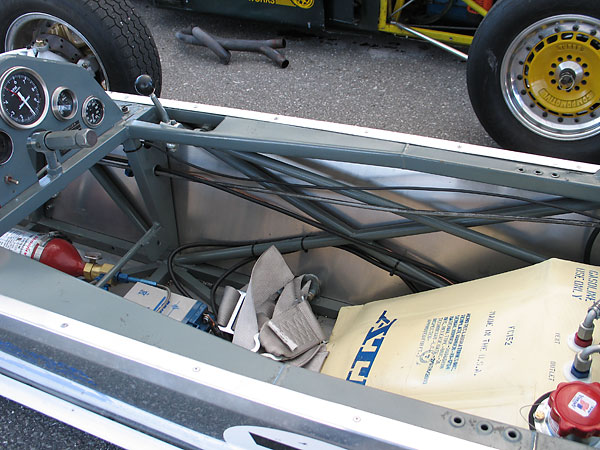
ATL FC152 5-gallon fuel cell.
Exterior
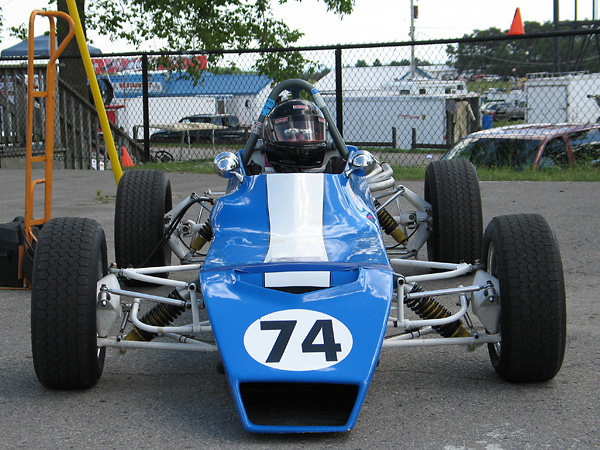
During VARAC's 31st Intl. Vintage Racing Festival at Mosport, Gord Leach piloted his vintage Hawke DL11
Formula Ford around the challenging 3.957Km racetrack with lap speeds of about 1 minute, 49 seconds.
That works out to an average speed of over 130.2kph (~80.9mph).
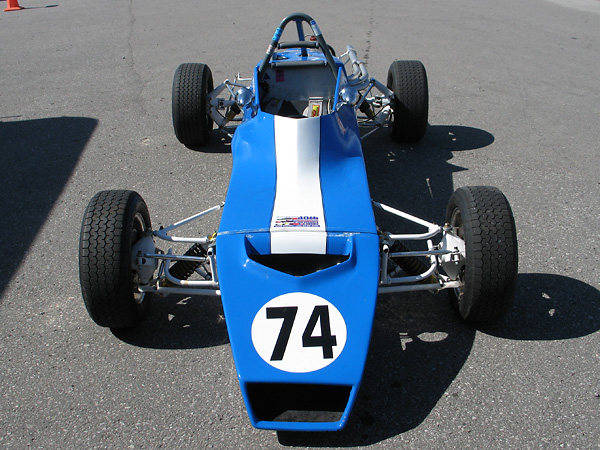
decal: United States 40th Anniversary of Formula Ford, Road America, July 24-26, 2009.
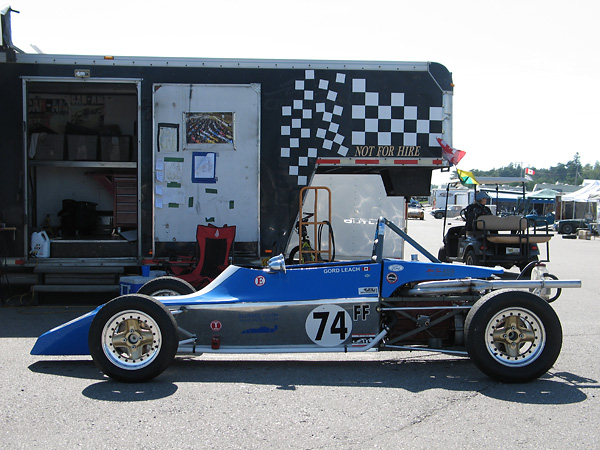
It sits high empty, but it will settle with nicely with the driver installed.
Factory reccommended ride height: 2.75"-3" (front) and 3.5"-3.75" (rear).
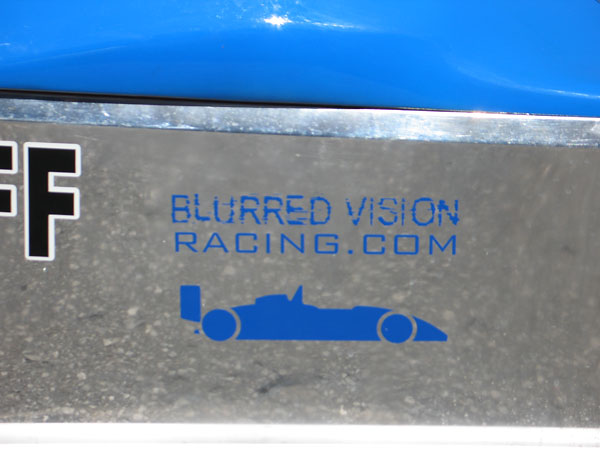
decal: BlurredVisionRacing.com
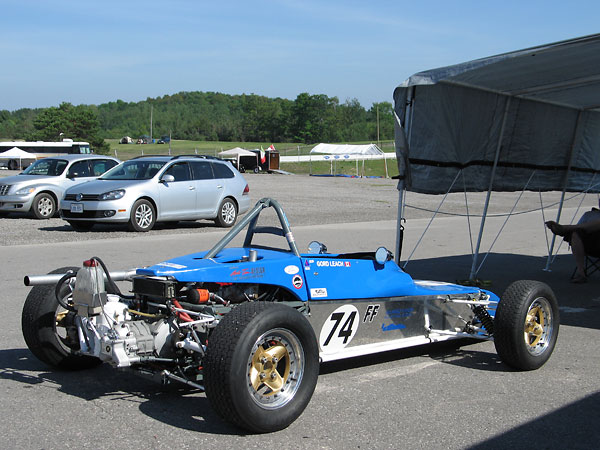
After a couple years of experience with side-pod mounted radiators, Lazenby returned to a single
nose-pod mounted radiator for the Hawke DL11. Coolant was routed in external lines by necessity.
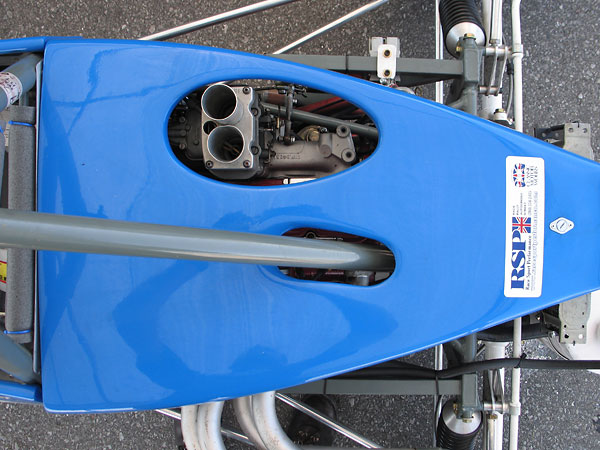
decal: Race Sport Performance of St. Andrews, Manitoba
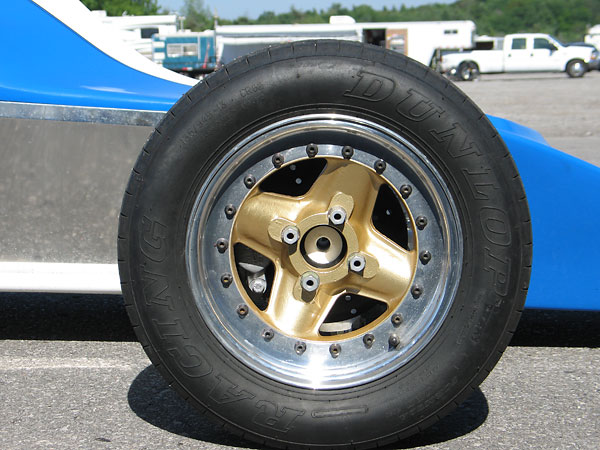
Revolution modular (3-piece) aluminum wheels.
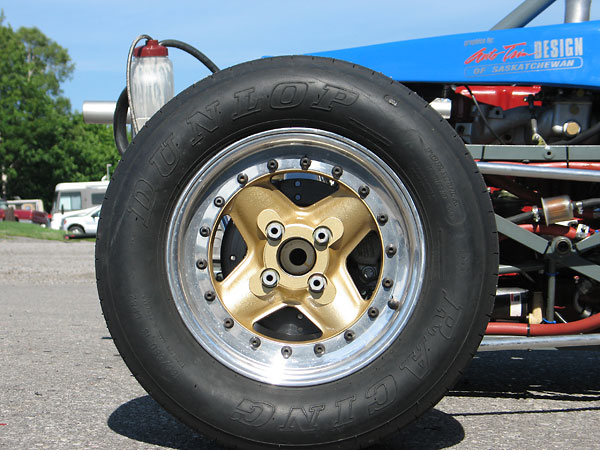
Dunlop Racing "Formula Ford" tires (135/545-13 CR82 front, 165/580-13 CR82 rear).
All photos shown here are from June 2010 when we viewed the car at VARAC's 31st Intl. Vintage Racing Festival
at Mosport Motorsports Park, in Ontario Canada. Photos by Curtis Jacobson for BritishRaceCar.com,
copyright 2010. All rights reserved.
| If you liked this article, you'll probably also enjoy these: | |||||
 |
Dick Leehr 1968 Lotus 51c |
 |
Scott Fairchild 1972 Royale RP3A |
 |
Michael Snowdon 1972 GRD 272 |
| You're invited to discuss anything you've seen here on The British Racecar Motorsports Forum! | |||||
Notice: all the articles and almost all the photos on BritishRacecar.com are by Curtis Jacobson.
(Photos that aren't by Curtis are explicitly credited.) Reproduction without prior written permission is prohibited.
Contact us to purchase images or reproduction permission. Higher resolution images are optionally available.


